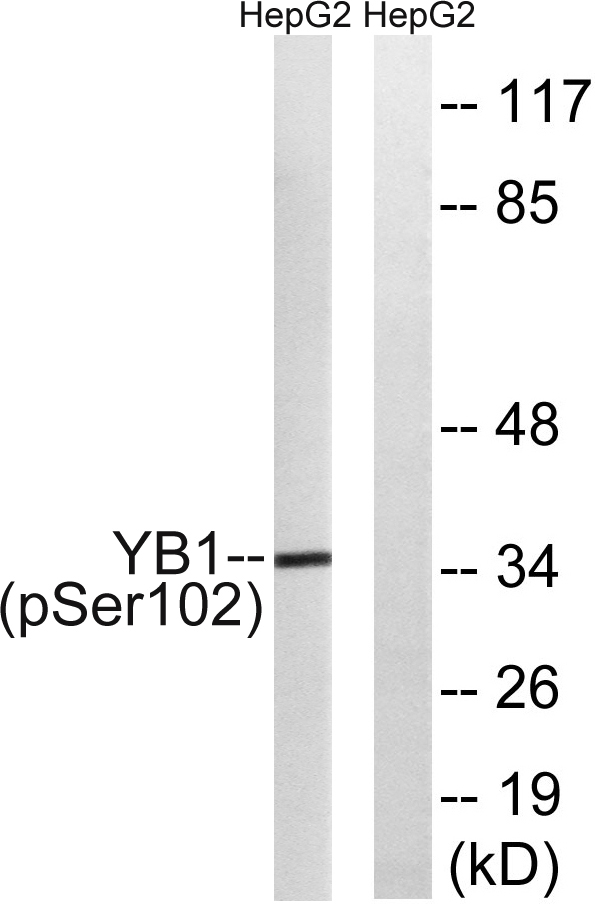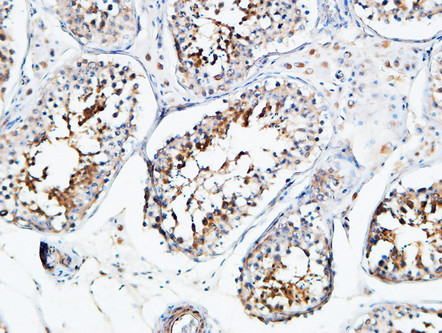YB-1 (phospho Ser102) Polyclonal Antibody
- Catalog No.:YP0489
- Applications:WB;ELISA
- Reactivity:Human;Mouse;Rat
- Target:
- YB-1
- Gene Name:
- YBX1
- Protein Name:
- Nuclease-sensitive element-binding protein 1
- Human Gene Id:
- 4904
- Human Swiss Prot No:
- P67809
- Mouse Gene Id:
- 22608
- Mouse Swiss Prot No:
- P62960
- Rat Gene Id:
- 500538
- Rat Swiss Prot No:
- P62961
- Immunogen:
- The antiserum was produced against synthesized peptide derived from human YB1 around the phosphorylation site of Ser102. AA range:68-117
- Specificity:
- Phospho-YB-1 (S102) Polyclonal Antibody detects endogenous levels of YB-1 protein only when phosphorylated at S102.
- Formulation:
- Liquid in PBS containing 50% glycerol, 0.5% BSA and 0.02% sodium azide.
- Source:
- Polyclonal, Rabbit,IgG
- Dilution:
- WB 1:500 - 1:2000. ELISA: 1:40000. Not yet tested in other applications.
- Purification:
- The antibody was affinity-purified from rabbit antiserum by affinity-chromatography using epitope-specific immunogen.
- Concentration:
- 1 mg/ml
- Storage Stability:
- -15°C to -25°C/1 year(Do not lower than -25°C)
- Other Name:
- YBX1;NSEP1;YB1;Nuclease-sensitive element-binding protein 1;CCAAT-binding transcription factor I subunit A;CBF-A;DNA-binding protein B;DBPB;Enhancer factor I subunit A;EFI-A;Y-box transcription factor;Y-box-binding protein 1;YB-
- Observed Band(KD):
- 36kD
- Background:
- This gene encodes a highly conserved cold shock domain protein that has broad nucleic acid binding properties. The encoded protein functions as both a DNA and RNA binding protein and has been implicated in numerous cellular processes including regulation of transcription and translation, pre-mRNA splicing, DNA reparation and mRNA packaging. This protein is also a component of messenger ribonucleoprotein (mRNP) complexes and may have a role in microRNA processing. This protein can be secreted through non-classical pathways and functions as an extracellular mitogen. Aberrant expression of the gene is associated with cancer proliferation in numerous tissues. This gene may be a prognostic marker for poor outcome and drug resistance in certain cancers. Alternate splicing results in multiple transcript variants. Pseudogenes of this gene are found on multiple chromosomes. [provided by RefSeq, Sep 2015],
- Function:
- function:Binds to splice sites in pre-mRNA and regulates splice site selection. Binds and stabilizes cytoplasmic mRNA. Contributes to the regulation of translation by modulating the interaction between the mRNA and eukaryotic initiation factors (By similarity). Binds to promoters that contain a Y-box (5'-CTGATTGGCCAA-3'), such as HLA class II genes. Regulates the transcription of numerous genes. Promotes separation of DNA strands that contain mismatches or are modified by cisplatin. Has endonucleolytic activity and can introduce nicks or breaks into double-stranded DNA (in vitro). May play a role in DNA repair.,PTM:Cleaved by a 20S proteasomal protease in response to agents that damage DNA. Cleavage takes place in the absence of ubiquitination and ATP. The resulting N-terminal fragment accumulates in the nucleus.,PTM:In the absence of phosphorylation the protein is retained in the cytopl
- Subcellular Location:
- Cytoplasm . Nucleus . Cytoplasmic granule . Secreted . Secreted, extracellular exosome . Predominantly cytoplasmic in proliferating cells (PubMed:12604611). Cytotoxic stress and DNA damage enhance translocation to the nucleus (PubMed:14718551). Localized in cytoplasmic mRNP granules containing untranslated mRNAs (PubMed:25229427). Shuttles between nucleus and cytoplasm (PubMed:25229427). Localized with DDX1, MBNL1 and TIAL1 in stress granules upon stress (PubMed:18335541). Secreted by mesangial and monocytic cells after inflammatory challenges (PubMed:19483673). .
- Expression:
- Adrenal cortex,Bone marrow,Brain,Epithelium,Eye,Kidney,Lung,Muscle,Placenta,Skin,Te
- June 19-2018
- WESTERN IMMUNOBLOTTING PROTOCOL
- June 19-2018
- IMMUNOHISTOCHEMISTRY-PARAFFIN PROTOCOL
- June 19-2018
- IMMUNOFLUORESCENCE PROTOCOL
- September 08-2020
- FLOW-CYTOMEYRT-PROTOCOL
- May 20-2022
- Cell-Based ELISA│解您多样本WB检测之困扰
- July 13-2018
- CELL-BASED-ELISA-PROTOCOL-FOR-ACETYL-PROTEIN
- July 13-2018
- CELL-BASED-ELISA-PROTOCOL-FOR-PHOSPHO-PROTEIN
- July 13-2018
- Antibody-FAQs
- Products Images

- Western blot analysis of lysates from HepG2 cells treated with PMA 125ng/ml 15', using YB1 (Phospho-Ser102) Antibody. The lane on the right is blocked with the phospho peptide.


